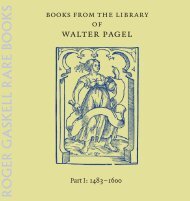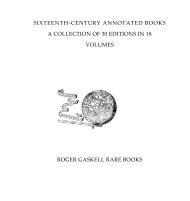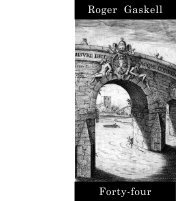pdf - Roger Gaskell Rare Books
pdf - Roger Gaskell Rare Books
pdf - Roger Gaskell Rare Books
You also want an ePaper? Increase the reach of your titles
YUMPU automatically turns print PDFs into web optimized ePapers that Google loves.
text; separate titlepages to the Rheticus dated 1621 (but the register<br />
and pagination continuous) and to the ‘Apologia’, dated 1622 with<br />
large woodcut printer’s device (on a1, starting the second register and<br />
pagination sequence).<br />
5 folding engraved plates. 1 engraving signed Chirstophorus Leibfried.<br />
V. Tübing: 1597’ (at p. 26) and 4 woodcuts with letterpress headings<br />
and captions (2 at p. 18 and at pp. 54 and 56).<br />
318 x 197mm. Worm holes and tracks in the upper and lower margins,<br />
not aVecting the text but touching a few lines and letters in the last<br />
two plates; quite heavy waterstaining throughout.<br />
Binding: Contemporary British blindruled calf, old rebacking with<br />
most of the original spine preserved. Endleaves at front and back<br />
removed.<br />
Provenance: Nineteenthcentury Inscription ‘Dupplin Castle R. 175.10’<br />
and shelf mark ‘H. C.31’ scored out and replaced with ‘H. 7.3.’<br />
Dupplin Castle is a mansion house in Strathearn, Perth and Kinross,<br />
built in 1828–32 to replace an earlier castle destroyed by Wre, the seat<br />
of the Hay Earls of Kinnoull. The mansion later became the home<br />
of the Perth whisky baron John Dewar, Lord Forteviot (1856–1929).<br />
Inscribed ‘Bernard Pagel MCMLVII’ in Walter Pagel’s hand.<br />
Second, enlarged edition of ‘Mysterium Cosmographicum’<br />
(Wrst 1596), containing, as in the Wrst edition, a reprint of<br />
Rheticus Narratio prima (Wrst 1540), and issued with the<br />
Wrst edition of Kepler’s Pro suo Opere Harmonices Mundia<br />
apologia. Caspar 67 and 68.<br />
Kepler’s Wrst book, usually referred to as ‘Mysterium Cosmographicum’<br />
is a Copernican treatise which set the course for<br />
his life’s work. It contains his theory that the orbit of each of<br />
the Wve planets is determined by the circumference of the Wve<br />
platonic solids nested one inside the other. This is illustrated in<br />
the famous engraved plate.<br />
As well as Kepler’s own introductory chapter expounding<br />
and defending the Copernican theory, the book contains a<br />
reprint of Rheticus’ Naratio prima, the Wrst announcement<br />
of the Copernican theory, Wrst published in 1540, before De<br />
revolutionibus in 1543. This second edition contains Kepler’s<br />
additional notes reXecting the development of his thinking in<br />
the intervening 25 years. Also appended is the Wrst edition of<br />
Kepler’s response to attacks by Robert Fludd on his Harmonices<br />
mundi of 1619.<br />
The illustration of the nested solids is a Wne engraving, copied<br />
in reverse from the engraving that appeared in the Wrst edition<br />
of 1596, and still bearing the date 1597 (it is not clear why the<br />
engraving was dated a year after the date on the titlepage of<br />
the book).<br />
‘Quixotic or chimerical as Kepler’s polyhedrons may appear<br />
today, we must remember the revolutionary context in which<br />
they were proposed. The Mysterium cosmographicum was







